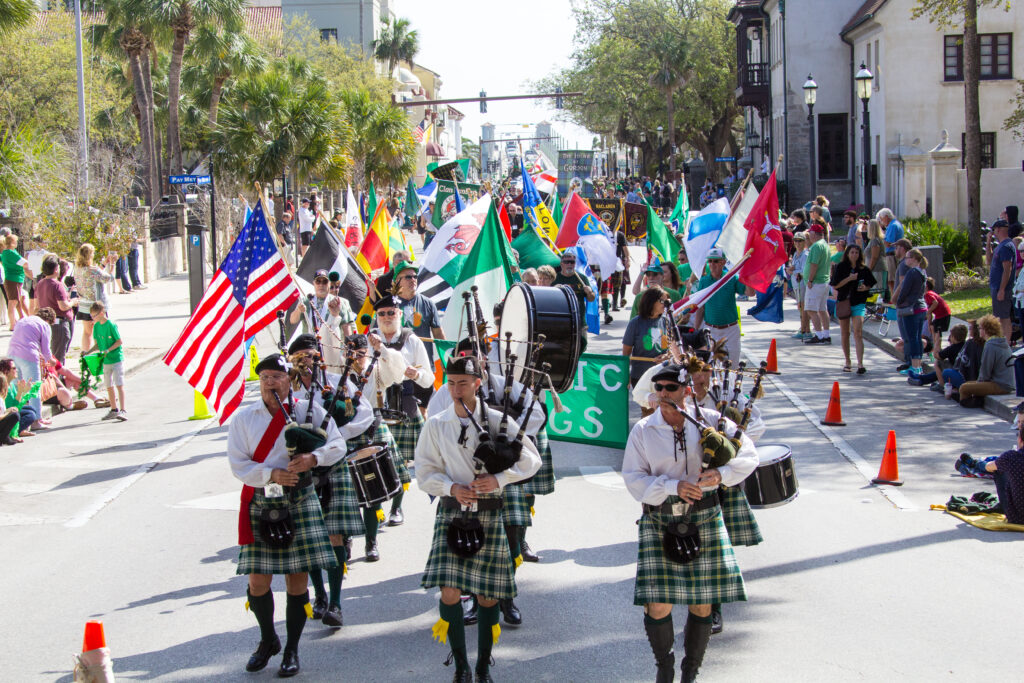Wasn’t Boston’s St. Patrick’s Day celebration the first in North America in 1737?
Wasn’t New York City’s the first St. Patrick’s parade in 1762?
Boston and New York, as centers of Irish immigration, are asserted to have started St. Patrick celebrations long before Ireland itself.
St. Patrick’s Day had previously been observed as a solemn occasion commemorating the death of the saint, not a celebration.
But a recent discovery in Spain establishes that St. Patrick’s Day celebrations started in St. Augustine, Florida over 100 years before New York or Boston.

According to University of South Florida history professor J. Michael Francis, PhD “The first recorded St. Patrick’s Day celebrations in the United States did not occur in Boston or New York. Rather, those who first gathered to venerate St. Patrick and process through city streets included a blend of Spaniards, Africans, Native Americans, Portuguese, a French surgeon, a German fifer, and at least two Irishmen, who marched together in honor of the Irish saint”.
In December 2017, Dr. Francis discovered documents In the Archivo General de Indies, Seville, Spain, that prove St. Augustine, Florida held its first St Patrick’s Day celebration in the year 1600 and its first St. Patrick parade in 1601.

In the Archivo, Dr. Francis found accounts of colonial St. Augustine’s gunpowder expenditures which showed that cannons were fired during several annual public celebrations and religious festivals.
Among the celebrations in 1600 and 1601 were two spring events in honor of the feast day of San Patricio, who was identified as the official “protector” of the city’s corn fields. And on March 17, 1601, St. Augustine’s celebrants again fired off cannons, then processed through the city’s streets in honor of an Irish saint. It turns out that “San Patricio” is the Spanish name for “Saint Patrick”.
“They had a St. Patrick’s Day in 1600, and they even had a parade” reports Dr. Francis.
And that’s years before Boston, New York, or Jamestown for that matter, even existed.
But why in this Spanish colony?
Spain’s colony of “La Florida” was established at St. Augustine in 1565. Its residents and soldiers included a diversity of Portuguese, Africans, French, Germans, Flemish, Native Americans, Celtic Spaniards from Spain’s northern region, and at least two Irishmen.
During England’s Protestant Reformation in the 16th Century, oppressed Irish Catholics often studied for the priesthood in Catholic Spain and then some served as vicars in Spanish colonies.
In that regard, the archive tells of Ricardo Artur (Richard Arthur), the Irish priest who likely introduced St. Patrick to the colony in its capital, St. Augustine. A former soldier himself, then in his 60s, Arthur served from 1597 to 1604 as chaplain to the soldiers in the fort at St. Augustine, as well as the city’s parish priest.
Another Irishman is also documented in the archive. Darby Glavin (to the Spanish he was David Glavid). Glavin had been a maritime merchant who was captured in 1584 by the English and forcibly conscripted to their Roanoke colony and then back to England when Roanoke failed. Years later he escaped servitude and defected to the Spanish in Puerto Rico. In 1597 he moved to St. Augustine where he earned a living as a soldier and a merchant. He was there in 1600 and 1601 and surely participated in the celebrations. After that, Arthur and the early celebrations disappear from the record.
“Irish are everywhere. Even in this small town on the frontiers of Spain’s empire, you have this priest introducing Africans and Native Americans and the Spanish to St. Patrick” says Dr. Francis.
On St. Patrick’s Day March 17, 1737, Boston’s Irish community joined together in the festivities of their homeland, as a gesture of solidarity among the city’s new Irish immigrants.
And New York can still claim tenure as the oldest continuous parade. New York City has had a St. Patrick’s Day Parade every year, storm or shine, since March 1762.
In 2025, the city of St. Augustine commemorates the 425th anniversary of this “First St. Patrick’s Day” celebration.
All three US celebrations came long before Ireland’s own first St Patrick’s Day parade in 1903.